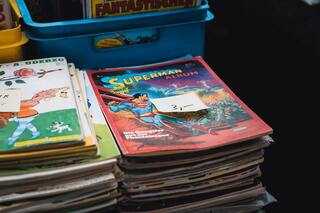|
by Skyla Everwine  Photo by Jo Szczepanska on Unsplash Photo by Jo Szczepanska on Unsplash The most punk-rock thing I did this semester was stand in line at a UPS and try not to cry. It wasn’t the basement shows or broken guitar strings, but being at UPS at 4 p.m. on a Tuesday. I had but one task: to print nine pages, double-sided and in color. And then do that until 50 more times. It was the fourth or fifth printer I had gone to in order to print the zine I was making. I had learned that commercial printers were hellish portals to untamable frustrations, and that making the project for my Self-Publishing course with Dr. Jason Luther was far more difficult than it needed to be. I had turned what could have been a single page mini-zine into 36 pages of digital and hand-collaged interviews.
1 Comment
 by Amanda Smera Few things make me angrier than when people read something I’ve written and point out my talent. The intentions, of course, always come from a good place and they mean no harm. And yet the bitter taste in my mouth never fails to feel discrediting. I want to scream from the top of my lungs: “I’VE BEEN WORKING ON THIS FOR A MONTH STRAIGHT, FOR YOU TO DARE AND ASSUME IT WAS JUST ‘MY TALENT’?!” It feels like an outdated myth that talent is a bigger force, that either you’ve got it, or you don’t. I have hundreds of thousands of school essays, Harry Potter fan fictions, and journal entries that prove that I was no Jane Austen at the age of five or fifteen. by Thomas LaPorte  Photo by Mika Baumeister on Unsplash Photo by Mika Baumeister on Unsplash A few weeks ago, I started reading “The Death of Superman” story arc. This was a massive comics storyline during the 1990s, one which is still discussed to this day. When I opened the first page, I noticed something I haven’t seen in a long time, something once considered a convention of comics: thought bubbles. See, I have dedicated my comic reading to issues from 2000-2011; by that time, thought bubbles had completely vanished from comic panels. In fact, comic storytelling overall had changed, and I believe a major part of it was due to the extinction of thought bubbles. Since superhero comics first made their appearance in 1938 with the dawn of Superman, thought bubbles were used to convey plot and inner dialogue; they were a staple of the comics genre. However, somewhere in the 1990s, the thought bubbles seemingly vanished from comics. Comic thought bubbles are a hindrance to modern comic books and they should stay gone. by Mark Krupinski  “Anything and everything can be art!” is, I feel, a deceptively sinister phrase. You could substitute the rather generic “art” in this situation with your medium of choice, be it poetry, film, literature, or what have you, and the situation remains unchanged. It seems innocuous at first, even encouraging. Anything can be art; no matter how lost you may feel, no matter what vision you lack, your expression has merit. You exist and you are valid. As someone who has spent more time than perhaps he’d like to admit pacing fretfully to and fro, hyperventilating into a McDonald’s bag because the words don’t sound the way they’re supposed to, I understand. Writing is a painful, clumsy, often fruitless task, so positive affirmation is as valuable as it is rare. But there’s a danger in creating that sense of comfort, tossing standards by the wayside in favor of blind positivity and confidence. The idea that everything, every single careless, thoughtless, witless, messy, wishy-washy, meandering, pointless thing is art gives me pause. |
Archives
July 2024
Categories
All
|
|
Glassworks is a publication of Rowan University's Master of Arts in Writing 260 Victoria Street • Glassboro, New Jersey 08028 [email protected] |
All Content on this Site (c) 2024 Glassworks
|

 RSS Feed
RSS Feed
